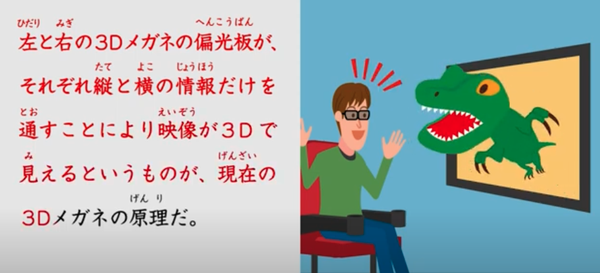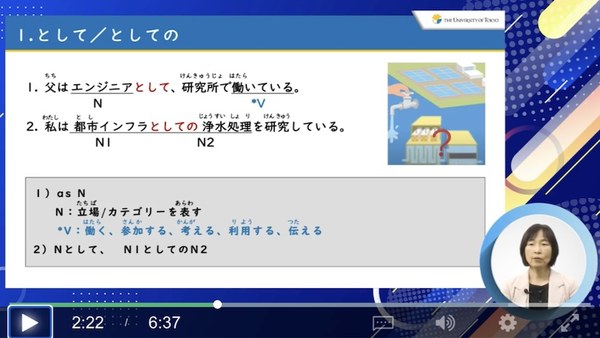Let's Read! Learning Japanese through Science & Technology ~ Epilogue ~
Let's Read! Learning Japanese through Science & Technology
Introduced into Classes of Overseas Universities
UTokyo MOOC, "Let's Read! Learning Japanese through Science & Technology," which teaches Japanese through the lens of science and technology, has been introduced as course material at universities abroad, including the Royal Institute of Technology (KTH) in Sweden, the Technical University of Munich (TUM), and the University of Munich.
At the Technical University of Munich (TUM), the B2-level Japanese conversation class, which is advanced-level, experimentally introduced the course in the summer of 2024. The participants with experience studying in Japan or those who had learned Japanese in their home countries found that they could easily understand grammar explanation videos in Japanese, and the interviews with professors were useful as challenging materials.
TUM implemented the course by combining Zoom lectures with the MOOC. Rather than following the lessons sequentially, students could select the lessons based on topics or grammar points that interested them. This approach allowed for discussions and presentations on specialized topics, with writing assignments based on their areas of expertise using the materials from each lesson.
"Let's Read! Learning Japanese through Science & Technology" consists of texts and videos created by specialized Japanese language instructors and interviews with faculty members from the Faculty of Engineering, the University of Tokyo. By using a content-based learning approach, the course enables learners to learn efficiently. This approach boosts learner motivation and helps them acquire higher-level language skills, including academic vocabulary.*1
Learners read texts on scientific and technological topics based on research from the University of Tokyo Faculty of Engineering, learn specialized vocabulary and key expressions related to engineering, and enjoy karaoke-style animated videos with voice and text. They also challenge themselves with practical listening exercises through interviews with researchers in the field, and tests assessing their understanding of grammar, vocabulary, and specialized content.

Reaching Learners Worldwide
The University of Tokyo's Japanese language department in the Faculty of Engineering has long deepened exchanges with U.S. and European universities through summer programs and other initiatives. Prof. Yumiko Furuichi actively provided information about the course to the universities abroad she visited after the launch of the MOOC to promote the program.
They have strengthened collaborations with Japanese language departments at partner universities and have supported the internationalization of the Faculty of Engineering and the University of Tokyo's educational initiatives. They visited partner universities in the UK, Sweden, Italy, France, and Switzerland, promoting multicultural understanding and international student exchange between the University of Tokyo and institutions like Caltech and the Indian Institutes of Technology. The university has also hosted visitors from Washington University in the U.S. and the University of Turin in Italy.
Through these exchanges, it became clear that varied interests in Japanese pop culture, traditional culture, history, and literature sparked the initial interest in learning the Japanese language. This broadening of interests reflects learners' diverse needs, enabling the university to identify concrete strategies to strengthen future collaborations and improve curricula.*2

Feedback from Learners
Feedback from students enrolled in the Japanese language classes was featured in the Japanese Language Class Annual Report issued by the School of Engineering of the University of Tokyo. Some of the comments are as follows:
"I liked the vocabulary built around common themes in science and technology. The topics were fascinating, and I enjoyed the interviews. I hope this course continues to be offered at the N2 level."
"The instructors were very kind, and thanks to the professors specializing in various topics, I became more interested in science. I hope to study at the University of Tokyo one day!"
Many learners have shared their joy about taking the course on social media. For example:
"The content of this course, focused on innovations in science and technology, was very interesting and broadened my perspective. My Japanese level is N4, so this N3-level course was a tough challenge but a great experience."
"The Japanese level of this course was easy for me, but learning about science at the University of Tokyo was a fantastic experience. I look forward to seeing more courses like this in the future."
The COVID-19 pandemic accelerated the spread of online learning and digital educational materials. On the other side, recent global conflicts and environmental changes have made accessing academic resources more difficult. The need for digital and online materials continues to grow.
*1, *2 Refer to the "Annual Report of the Japanese Language Class at the Graduate School of Engineering" for 2022 and 2023.
Japanese Language Class, School of Engineering, The University of Tokyo
Let's Read! Learning Japanese through Science & Technology Part 1
Let's Read! Learning Japanese through Science & Technology Part 2

